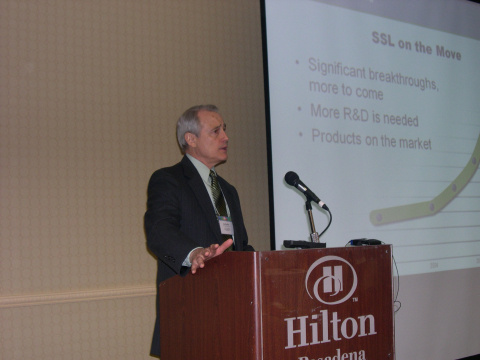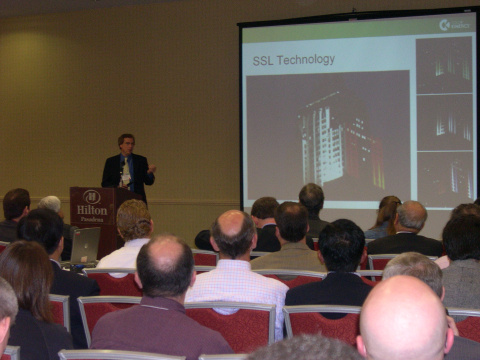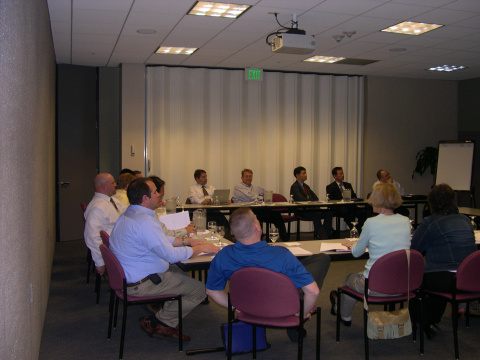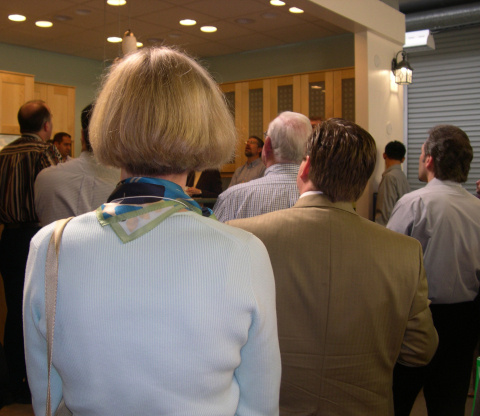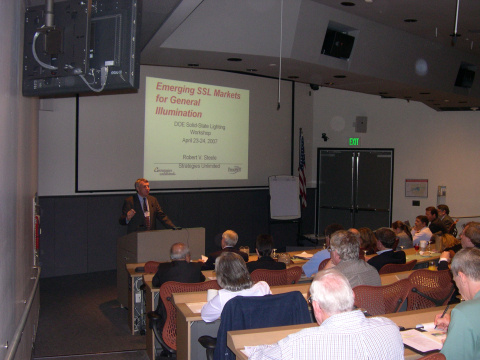Over 100 attendees gathered in Pasadena, California, to participate in the "Voices for SSL Efficiency" DOE Solid-State Lighting Workshop on April 23-24, 2007. The workshop, hosted by DOE and Southern California Edison, was designed to initiate a dialogue on how Federal, State, and private-sector organizations can work together to guide market introduction of high efficiency, high-performance SSL products. Participants from energy efficiency organizations, utilities, government, and industry shared insights, ideas, and updates on the rapidly evolving SSL market.
Beginning a Dialogue
DOE SSL Program Manager James Brodrick kicked off the workshop by highlighting recent developments in SSL – significant efficacy breakthroughs, and commitments from early adopters like Wal-Mart and the California Home Builders to encourage widespread use of SSL. Brodrick reviewed DOE's national strategy to push SSL technology and the market to the highest efficiency and the highest lighting quality, emphasizing opportunities to partner and participate with DOE.
Back to Basics
Kevin Dowling of Color Kinetics presented a broad introduction to SSL technology, discussing the technology status, advantages and disadvantages, current applications, and future potential. Market trends show rapid increases in efficiency, falling costs, and significant progress on technical issues. Dowling detailed the anatomy of an intelligent LED lighting solution, and described a number of current applications that take advantage of the inherent advantages of LEDs.
Linda Sandahl of the Pacific Northwest National Laboratory (PNNL) then presented an overview of the DOE report Compact Fluorescent Lighting in America: Lessons Learned on the Way to Market. The report provides an analysis of the market introduction of CFLs, identifying lessons learned that could be applied to the introduction of other lighting technologies such as SSL.
DOE SSL Strategy
"DOE has a Congressional directive to support SSL research, development, and commercial application activities for the federal government," James Brodrick said in his overview of the DOE SSL Portfolio, adding that the Department also has the "plan, partners, and programs" to carry out this directive. Brodrick cited DOE's partnerships with the Next Generation Lighting Industry Alliance and the Illuminating Engineering Society of North America, as well as over 150 market-side partners and 18 federal agency partners who are supporting deployment efforts. In addition, Brodrick announced that the Northeast Energy Efficiency Partnerships (NEEP) and the Consortium for Energy Efficiency (CEE) have been competitively selected as lead organizations to establish the DOE SSL Technical Information Network.
Marc Ledbetter, Emerging Technologies Program Manager at PNNL, next presented DOE's Five-Year SSL Commercialization Support Plan. Ledbetter discussed the primary market barriers for SSL and outlined key elements of the DOE plan to address these barriers, including buyer/user guidance, design competitions, technology demonstrations/procurements, product testing, and support for standards and test procedures.
Input on DOE Priorities
A core activity of the two-day workshop involved breakout sessions where participants explored case studies based on five hypothetical SSL products intended for various market applications. Leaders from each group reported their results and recommendations to all attendees at the end of the exercise. This input will help to determine if DOE commercialization plan elements adequately support the market introduction needs of new SSL products, and will serve to identify major stakeholders and the elements of the plan where their participation might be most valuable.
An evening reception, sponsored by the Next Generation Lighting Industry Alliance, offered attendees an opportunity for further discussion, networking, and brainstorming on market challenges and issues.
A Utility's Perspective
Day 2 began with a tour of Southern California Edison's Customer Technology Application Center, where customers and builders can touch and see new energy-efficient technologies in action. The Center's Lighting Classroom features interactive installations, and the Lighting Technology Center is a laboratory for both teaching and testing new technologies. Gregg Ander, Chief Architect at Southern California Edison, discussed the challenges facing a major utility in California these days. In an effort to avoid rotating outages and blackouts, SCE and other utilities in the state are under a mandate to reduce energy consumption by 1 billion kilowatt hours per year from 2009-2013. "SSL is important in these energy reduction efforts," Ander said. He described SCE's efforts to support demonstrations of near market ready products, including hybrid LED pathway lights and LED streetlights. "We are aggressively looking for partners." More information is available at The Emerging Technologies Coordinating Council.
Emerging Markets for SSL
Robert Steele of Strategies Unlimited presented an analysis of the high-brightness LED market for lighting. The 2006 market was $26 million, and growing at around 37% each year. The market is projected to reach $1 billion in 2011. While the majority of today's applications use RGB, Steele's forecast indicates the use of white LEDs will increase to more than 60% of the market by 2011.
DOE Commercialization Plan Elements
The PNNL team then provided a closer look at the DOE Commercialization Support Plan elements.
- Kelly Gordon offered an overview of the Lighting for Tomorrow design competition, which encourages and recognizes attractive, energy-efficient residential lighting fixtures.
- Bruce Kinzey described DOE's Technology Demonstrations, designed to verify performance of selected SSL products in appropriate applications.
- Mia Paget then discussed DOE's SSL Commercial Product Testing Program, which conducts independent testing of commercially-available SSL products for general illumination.
- Jeff McCullough detailed the requirements of the draft ENERGY STAR criteria for SSL products for general illumination.
- Eric Richman reported on DOE's activities to support the development of new standards and test procedures related to SSL.
Enabling SSL Technology
During lunch, Ian Ashdown of TIR Systems Limited spoke to attendees about the need to approach SSL from a systems perspective. "We have high-flux LEDs, but we are still learning how to best use them in the design of SSL products," said Ashdown. Luminaire manufacturers, lighting designers, and specifiers must address issues related to electronics, optics, thermal management, and other key areas before SSL can become as commonplace as traditional lighting sources.
Brodrick concluded the two-day workshop with a reminder to participants that there are multiple opportunities to partner and participate with DOE, and shape the future of lighting in the U.S. For ongoing updates on DOE SSL activities and events, register for SSL UPDATES.


